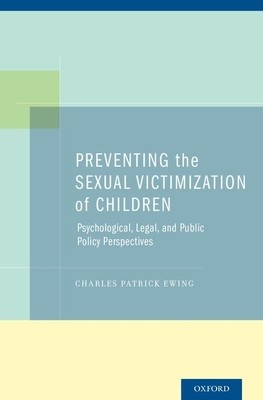
- We will send in 10–14 business days.
- Author: Charles Patrick Ewing
- Publisher: Oxford University Press, USA
- ISBN-10: 0199895538
- ISBN-13: 9780199895533
- Format: 16 x 23.9 x 2.8 cm, hardcover
- Language: English
- SAVE -10% with code: EXTRA
Preventing the Sexual Victimization of Children (e-book) (used book) | bookbook.eu
Reviews
Description
Sexual exploitation of children is a major social problem in the United States and around the world. Depending upon how such exploitation is defined and measured, divergent estimates indicate that in the U.S. between 3 and 37 percent of males, and between 8 and 71 percent of females are sexually abused in some manner during childhood or adolescence. In response, governments have passed strict laws, entered into international treaties, and established large bureaucracies aimed at curbing child sexual abuse.
Preventing the Sexual Victimization of Children is the first book to critically evaluate national and international efforts to reduce child sexual abuse (CSA) and ameliorate its effects. Until now, input from social science and mental health experts has been accepted for the most part uncritically, as have the programs and laws that have been developed in reliance upon that advice. Here Dr. Ewing utilizes empirical data, policy considerations, cost-benefit analyses, psychological theory, legal reasoning, and common sense to undertake the often difficult and sometimes controversial task of distinguishing prevention strategies that are likely to prevent CSA from those that are not. He concludes that the most expensive preventive strategies-such as sex offender registration, enhancing criminal penalties for such offenders, and civilly confining them-are not effective in preventing CSA and may actually increase its likelihood. However, he also concludes that many other strategies are orcould be effective in preventing CSA, such as minimizing opportunities for such abuse, risk education, teaching children to protect themselves, encouraging bystander intervention, limiting the cultural sexualization of children, improving the investigation and prosecution of CSA allegations, using technology to stop child pornography and to rescue its victims, changing the culture in child-serving organizations, and more. This volume will be a unique and critical resource for lawyers, researchers, psychologists, social workers, public policy officials, students, and child advocates interested in preventing child sexual abuse.
EXTRA 10 % discount with code: EXTRA
The promotion ends in 19d.04:24:14
The discount code is valid when purchasing from 10 €. Discounts do not stack.
- Author: Charles Patrick Ewing
- Publisher: Oxford University Press, USA
- ISBN-10: 0199895538
- ISBN-13: 9780199895533
- Format: 16 x 23.9 x 2.8 cm, hardcover
- Language: English English
Sexual exploitation of children is a major social problem in the United States and around the world. Depending upon how such exploitation is defined and measured, divergent estimates indicate that in the U.S. between 3 and 37 percent of males, and between 8 and 71 percent of females are sexually abused in some manner during childhood or adolescence. In response, governments have passed strict laws, entered into international treaties, and established large bureaucracies aimed at curbing child sexual abuse.
Preventing the Sexual Victimization of Children is the first book to critically evaluate national and international efforts to reduce child sexual abuse (CSA) and ameliorate its effects. Until now, input from social science and mental health experts has been accepted for the most part uncritically, as have the programs and laws that have been developed in reliance upon that advice. Here Dr. Ewing utilizes empirical data, policy considerations, cost-benefit analyses, psychological theory, legal reasoning, and common sense to undertake the often difficult and sometimes controversial task of distinguishing prevention strategies that are likely to prevent CSA from those that are not. He concludes that the most expensive preventive strategies-such as sex offender registration, enhancing criminal penalties for such offenders, and civilly confining them-are not effective in preventing CSA and may actually increase its likelihood. However, he also concludes that many other strategies are orcould be effective in preventing CSA, such as minimizing opportunities for such abuse, risk education, teaching children to protect themselves, encouraging bystander intervention, limiting the cultural sexualization of children, improving the investigation and prosecution of CSA allegations, using technology to stop child pornography and to rescue its victims, changing the culture in child-serving organizations, and more. This volume will be a unique and critical resource for lawyers, researchers, psychologists, social workers, public policy officials, students, and child advocates interested in preventing child sexual abuse.


Reviews